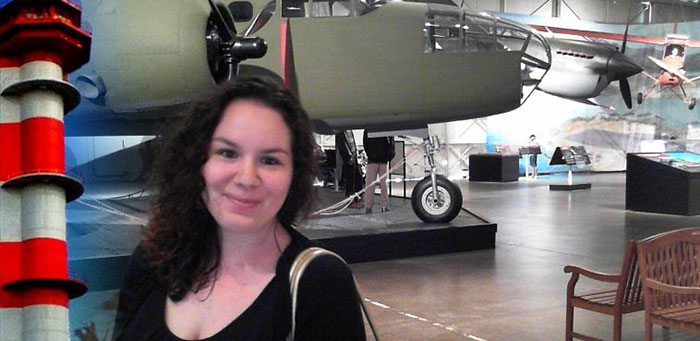
Meet Liana Roberson
Liana Roberson served as a map watchstander during the 2016 Deepwater Exploration of the Marianas expedition. Read the full text of Liana's interview below to learn more about her experiences on the ship.
About Liana's Role
What were your duties as an Explorer-in-Training?
I worked as a map watchstander to: 1) process incoming multibeam sonar data using 3D and 4D visualization softwares such as CARIS, DMagic, and Fledermaus; 2) collect sound velocity profile data; and 3) take marine aerosol readings during the day to contribute to an ongoing NASA project.
Which school are you attending?
I attend the University of Hawaii at Manoa, working towards a Master's in Geography with a specialization in Remote Sensing.
Where was your work experience located? If you were working at sea, what were your impressions of living and working on a ship?
I gained mapping experience aboard NOAA Ship Okeanos Explorer. I can only relate the experience of working and living on a research vessel to a three-month summer course I took at the Hawaii Institute of Marine Biology (HIMB) during my undergrad at the University of Hawaii-Manoa. I lived on Coconut Island in Kaneohe Bay with six or seven other students, mapping the patch reefs in the bay. On the Okeanos Explorer, I learned about the other students' backgrounds and their accomplishments and career goals, and it made me step back at times and appreciate my position onboard the vessel.
What sparked your initial interest in ocean sciences?
When I was younger, I was fascinated with marine mammals and invertebrates. I was never exposed to them in school, until I went to college in Hawaii where I fell in love with the ocean and marine life. In a few courses during my undergraduate studies, I used GIS to study the spatial distribution and abundance of endemic marine invertebrates, and from there, my interest in mapping both the seafloor and marine life took off.
What was the most personally rewarding part of your experience?
Personally, considering our unexpected delay in beautiful Saipan, the chance to see part of the Mariana Islands was very rewarding. Professionally, learning the softwares that are used to process and visualize the bathymetric sonar are rewarding since I've never worked with them in the past, and they can be extremely helpful in my future.
What is the most unexpected thing you have learned?
Despite all the preparations before a mission, one has to expect the unexpected. This was the biggest surprise for this leg. Also, the ways in which I can manipulate and visualize deep-sea sonar data, either three-dimensionally or four-dimentionally, are really amazing considering the way that data were collected from below the vessel. Sonar data is collected during our mission occurs 24/7, something I wasn't aware of, and it's crucial to the scientists we communicate with on land that we continuously process the new incoming data.
How do you see this experience fitting in with your future career plans?
The mapping experience from this cruise directly relates to what I want to do in my future. I want to be involved in the entire research process, from data acquistion, to processing, analyzing, and reporting. My ideal career would be in conservation biology, involving benthic habitat mapping of coral reefs and marine mammal protection, and my experience as a watchstander on this leg will provide me with new skills I can use in future mapping research.